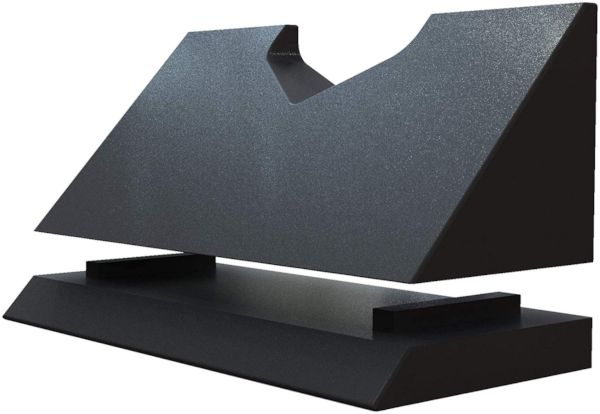Neck Curve Restoration: Improving Form & Function Using The Neck Wedge For The Cervical Spine
As form relates to function, deterioration of the cervical spine is often related to loss of the natural biomechanical curve of the cervical spine. The neck wedge is an orthotic device that is very affordable and versatile. It is an easy to use tool to aid in restoring form and function of the neck through neck curve restoration. This often leads to better heath and relief of discomfort in the neck and upper back as well as headaches.
Deteriorating form from head forward postures often leads to related decline in in function of the cervical spine. With it’s associated muscles, tendons, ligaments, discs, nerves and blood vessels; biomechanical stress from loss of the natural neck curve can have far reaching effects. As ergonomics has become a commonplace term, we realize the long hours working at a computer, smart phones and and injuries has a negative effect on the entire body. Restoration of the cervical spine curve has become a common goal of people suffering from symptoms like neck pain, upper back and shoulder pain, jaw joint pain and other conditions. This has been a focus of many bio-mechanically oriented Chiropractors for years.
- A 2019 study in the journal Medicine (Baltimore) found in neck pain patients 40 and under, improving the neck curve reduced the degree of disc herniation and increased height of the disc space. The authors stated, “These findings may indicating a link between cervical curvature and degenerative changes which have important clinical implications.”
- A 2021 study in the journal Cureus found that the risk of Modic changes, a rapid form of degeneration, increases with loss of the cervical curve, along with disc degeneration and facet joint degeneration.
Methods Of Neck Curve Restoration
For those with chronic or long standing loss of curve, osteoarthritis or disc degeneration often results as we age. Restoration may help slow down or even stop the progression of a straightened or military neck, and may help to normalize both form and function. Depending on the severity of curve loss, restoring the curve takes place over time, with no quick fix. Using proper spinal ergonomics when working for long periods, spinal decompression with cervical traction devices, a properly supportive pillow for sleeping, and effective exercises and stretches all play an important role.
As a tool for cervical spine curve restoration, the neck wedge is a cervical orthosis that is a great way to augment the process of improving form and function of the cervical spine. While no one method is perfect, a combination of these methods is necessary for best results, and the the neck wedge is a very versatile, result oriented tool that is easy to use and very affordable.
The Neck Wedge
The wedge is made of closed cell foam that does not lose it’s shape over time. It is also adjustable with a removable base that essentially allows it to comes in 2 sizes, because one size does not fit all, so be cautious of those promoting a wedge with only one height. It is an ergonomically designed foam triangle with a cutout for the cervical spine. In general, if you are just starting out, use the lower version first and progress to the taller size in 3 to 6 months.
For correcting the curve, begin lying on the wedge using the cutout under your neck. Use on the floor or when lying in bed, the wedge can help restore the natural spinal position. Cross your arms in front of your chest to rotate the scapulae around. By using a process called hysteresis, a gradual lowering of the resistance from ligaments and spinal discs, makes improving cervical spine form and function achievable, easy as well as pain free.
After you become used to the process, you can begin using some more advanced methods. You can turn the wedge over and use the part without the cutout for an increased effect and you can use it for the lower, mid or upper cervical areas. You can also go through ranges of motion; turning your head to the right and left, use the special pain relieving neck exercise, and you can bend your knees and push with your hands on your thighs to increase pressure at the cervical spine.
When Is The Best Time To Use The Neck Wedge?
Although it can be used anytime, the best time to use it for spinal rehabilitation is before sleeping. With a biomechanically sound, ergonomic pillow, the benefits of the wedge are extended while sleeping. So, using the wedge should be a relaxing experience, slowly and gradually shaping the neck. Progressing to more advanced methods for use during the day.
Who Should Not Use The Wedge?
Cases of recent and acute injury, pinched nerves, spinal stenosis may not respond well to this therapy. A quick test would be to tilt your head back, look up at the ceiling and see if you experience any pain or dizziness. If so, do not use. Consult your health care professional for pre-existing conditions and follow specific instructions from your chiropractor when prescribed for neck curve restoration.
More About Using The Neck Wedge & How To Order Now!
A 2021 study in Scientific Reports found that restoration of the of the normal cervical curve from hypolordosis/military neck and head forward posture has a direct influence on the central conduction time. This is the time taken for nerve impulses to travel the central nervous system to the target muscles.
Prolongation of central conduction time is due to slowing of conduction by rapid conducting fibers, as seen in various disorders such as multiple sclerosis, amyotrophic lateral sclerosis, stroke, myelopathy, and neurodegenerative disorders like multiple system atrophy and progressive supranuclear palsy. These conditions often require special head supports.



